
British anti-invasion preparations of 1803–1805
Encyclopedia
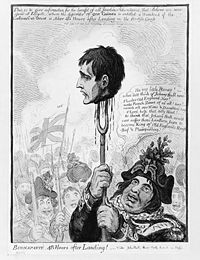
United Kingdom
The United Kingdom of Great Britain and Northern IrelandIn the United Kingdom and Dependencies, other languages have been officially recognised as legitimate autochthonous languages under the European Charter for Regional or Minority Languages...
to Napoleon
Napoleon I of France
Napoleon Bonaparte was a French military and political leader during the latter stages of the French Revolution.As Napoleon I, he was Emperor of the French from 1804 to 1815...
's planned invasion of the United Kingdom. They included mobilisation of the population on a scale not previously attempted in Britain, with a combined military force of over 615,000 in December 1803. Much of the southern English coast was fortified to repel a French landing. However Napoleon never attempted his planned invasion and so the preparations were never put to the test.
Background
In the aftermath of the French RevolutionFrench Revolution
The French Revolution , sometimes distinguished as the 'Great French Revolution' , was a period of radical social and political upheaval in France and Europe. The absolute monarchy that had ruled France for centuries collapsed in three years...
of 1789 Britain and France were at war almost continuously from 1793 to 1802
French Revolutionary Wars
The French Revolutionary Wars were a series of major conflicts, from 1792 until 1802, fought between the French Revolutionary government and several European states...
, and then from 1803 to 1815
Napoleonic Wars
The Napoleonic Wars were a series of wars declared against Napoleon's French Empire by opposing coalitions that ran from 1803 to 1815. As a continuation of the wars sparked by the French Revolution of 1789, they revolutionised European armies and played out on an unprecedented scale, mainly due to...
, interrupted by the brief Peace of Amiens
Treaty of Amiens
The Treaty of Amiens temporarily ended hostilities between the French Republic and the United Kingdom during the French Revolutionary Wars. It was signed in the city of Amiens on 25 March 1802 , by Joseph Bonaparte and the Marquess Cornwallis as a "Definitive Treaty of Peace"...
of 1802–3 and Napoleon's first exile at Elba
Elba
Elba is a Mediterranean island in Tuscany, Italy, from the coastal town of Piombino. The largest island of the Tuscan Archipelago, Elba is also part of the National Park of the Tuscan Archipelago and the third largest island in Italy after Sicily and Sardinia...
in 1814–15. In late 1797, Napoleon said to the French Directory
French Directory
The Directory was a body of five Directors that held executive power in France following the Convention and preceding the Consulate...
that:
[France] must destroy the English monarchy, or expect itself to be destroyed by these intriguing and enterprising islanders...Let us concentrate all our efforts on the navy and annihilate England. That done, Europe is at our feet.
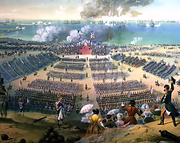
Henry Addington, 1st Viscount Sidmouth
Henry Addington, 1st Viscount Sidmouth, PC was a British statesman, and Prime Minister of the United Kingdom from 1801 to 1804....
and Napoleon viewed the peace as temporary, and so it was, with Britain declaring war on France on 18 May 1803. William Pitt
William Pitt the Younger
William Pitt the Younger was a British politician of the late 18th and early 19th centuries. He became the youngest Prime Minister in 1783 at the age of 24 . He left office in 1801, but was Prime Minister again from 1804 until his death in 1806...
replaced Addington as Prime Minister on 10 May 1804.
In 1803 Napoleon turned his attention to invading England once more, saying: "All my thoughts are directed towards England. I want only for a favourable wind to plant the Imperial Eagle on the Tower of London". Napoleon now planned an invasion on a bigger scale than 1798 and 1801, and built a new armada for the effort. He assembled the Grande Armée of over 100,000 at Boulogne
Boulogne-sur-Mer
-Road:* Metropolitan bus services are operated by the TCRB* Coach services to Calais and Dunkerque* A16 motorway-Rail:* The main railway station is Gare de Boulogne-Ville and located in the south of the city....
.
British armed forces
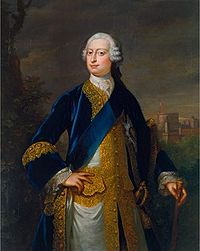
Regular Army
Addington's government had kept the Regular army at 132,000 men during the Amiens interlude, with 18,000 in Ireland and 50,000 in Great Britain (the rest serving abroad).Army of Reserve
In 1803 50 of the 93 regiments of the Army gained a second battalion, which became known as the Army of Reserve. These 50,000 men would be raised by ballot within one year. However each recruit was liable to serve in Great Britain only. These Reserve soldiers could volunteer as Regular soldiers and consequently receive money. After 9 months recruiting fewer than 3,000 of the 42,000 men were balloted men. Within one month of recruiting it had enlisted 22,500 men but by the end of 1803 it was short of the required 50,000 by 15,000 so the government stopped recruiting for it.Militia
The Militia was a territorial-based infantry to be used only for home defence and was not a standing army. It was to be raised by ballot. The government in December 1802, fearing war, held a Militia ballot. The ballot was run by churchwardens and overseers of the poor in each parish. A list of men aged between eighteen and forty-five, with many exceptions (such as seamen and Thames watermen), was posted on the front of the church door. However if a man found himself on the list he could get out of serving by paying a fine or getting another man to fill his place. Four months after the ballot, and a week into the war, the Militia was filled to 80% of the 51,000 required.Volunteers
The British government had no choice—in view of Napoleon's avowed determination to invade the United Kingdom—but to rely on the patriotism of the people through a volunteer movement. The volunteers' function, as laid down in July 1803 by the Commander-in-Chief of the ForcesCommander-in-Chief of the Forces
The Commander-in-Chief of the Forces, or just the Commander-in-Chief , was the professional head of the British Army from 1660 until 1904, when the office was replaced by the Chief of the General Staff, soon to become Chief of the Imperial General Staff . From 1870, the C-in-C was subordinate to...
, Prince Frederick, Duke of York
Prince Frederick, Duke of York and Albany
The Prince Frederick, Duke of York and Albany was a member of the Hanoverian and British Royal Family, the second eldest child, and second son, of King George III...
, was to conduct guerrilla warfare against the French occupying forces. They would operate in small bodies to harass, instill panic and wear out the French army. They were never to get deeply engaged with French troops and to retire when pressed. Local knowledge was to be used as much as possible and they were also expected to cut off French pillaging detachments. In anticipation to criticisms that arming the people was dangerous, the Secretary at War in Addington's government (Charles Yorke
Charles Philip Yorke
Charles Philip Yorke PC, FRS, FSA , was a British politician. He notably served as Home Secretary from 1803 to 1804.-Background:...
) said on 18 July, 1803 in introducing a Bill for amending the Defence of the Realm Act:
I say, that in these times, it is better to run the hazard even of the people making a bad use of their arms, than that they should be actually left in a state of entire ignorance of the use of them. For my own part, I can safely aver, that I cannot see any real danger which is likely to accrue to the internal peace of the Country, when I consider the present dispositions and feelings of the people.
William Pitt, in response, agreed:
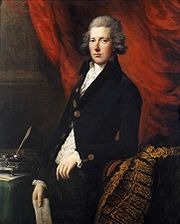
I am sure there is not an heart that palpitates in a British bosom that will not rouse for the common cause, and cordially join for the defence of the country. ... That there was a time, Sir, when it would have been dangerous to entrust arms with a great portion of the people of this country, I have strong reasons to know, because it must be in the recollection of every man that incendiaries were at work amongst them; and so successful in the promulgation of revolutionary doctrines, as to have disposed them to exert any means, however desperate, which they thought could be successful, in subverting the Government and Constitution. But that time is now past; and, I trust, those who have been so grosly deluded have seen their error. At least I am convinced, that if any such there still remain, the portion is so small, that if armed and dispersed in the same ranks with their loyal fellow subjects, they would be converted by their example; and, like them, rejoice in the blessings of our happy constitution; like them glory to live under its auspices, or die in its defence.
Even the prominent anti-war MP Charles James Fox
Charles James Fox
Charles James Fox PC , styled The Honourable from 1762, was a prominent British Whig statesman whose parliamentary career spanned thirty-eight years of the late 18th and early 19th centuries and who was particularly noted for being the arch-rival of William Pitt the Younger...
supported the Bill:
This is the first measure which I could...come down to support, being a measure for the defence of the country...the mass of the country; acting, not in single regiments, but as a great mass of armed citizens, fighting for the preservation of their country, their families, and every thing that is dear to them in life...an armed mass of the country, who are bound by every feeling and by every tie to defend that country to the last drop of their blood, before they will give way to him and his invading forces.
During 1803 the government's call for volunteers to resist an invasion was met with a massive response. However the government was unprepared for the numbers of volunteers, as within a few weeks 280,000 men had volunteered. On 18 August Addington issued a circular discouraging new volunteers "in any county where the effective members of those corps, including the yeomanry, shall exceed the amount of six times the militia". This had little effect since by the first week of September there were 350,000 volunteers. At least half of the volunteers of the summer and autumn of 1803 were not equipped with their own weapon. When the government tried to issue them with pike
Pike (weapon)
A pike is a pole weapon, a very long thrusting spear used extensively by infantry both for attacks on enemy foot soldiers and as a counter-measure against cavalry assaults. Unlike many similar weapons, the pike is not intended to be thrown. Pikes were used regularly in European warfare from the...
s this was met with contempt and attacked by the Opposition leader William Windham
William Windham
William Windham PC, PC was a British Whig statesman.-Early life:Windham was a member of an ancient Norfolk family and a great-great-grandson of Sir John Wyndham. He was the son of William Windham, Sr. of Felbrigg Hall and his second wife, Sarah Lukin...
.
The second half of 1803 marked the height of the invasion scare. When the King reviewed 27,000 volunteers in Hyde Park, London
Hyde Park, London
Hyde Park is one of the largest parks in central London, United Kingdom, and one of the Royal Parks of London, famous for its Speakers' Corner.The park is divided in two by the Serpentine...
on 26 and 28 October 1803, 500,000 people were estimated to have turned out on each of the two days to witness the event. The Chief Constable of Bramfield (John Carrington) travelled from Hertfordshire to see it, saying: "I never saw such a sight all my days". These were the best-attended of reviews of volunteers which between 1797 and 1805 "were often of daily occurrence".
In 1804 returns to Parliament recorded a total of 480,000 volunteers in uniform. In addition there were the regular forces and the militia, which meant that nearly one-in-five able-bodied men were in uniform. The Speaker, addressing the King at the prorogation of Parliament on 13 August 1803, said "the whole Nation has risen up in Arms". Addington called the volunteer movement on 4 September 1803 "an insurrection of loyalty". The response to the call to arms to resist invasion in these years has impressed some historians: "If some dissentient voices were heard in 1797–8 when the aftermath of the Revolution still lingered in the land, there was increased enthusiasm in the patriotism of 1801, and burning ardour coupled with absolute unanimity in that of 1803–5".
Royal Navy
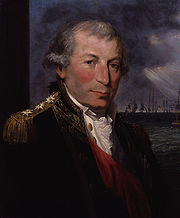
Royal Navy
The Royal Navy is the naval warfare service branch of the British Armed Forces. Founded in the 16th century, it is the oldest service branch and is known as the Senior Service...
kept a constant blockade of French harbours from Toulon
Toulon
Toulon is a town in southern France and a large military harbor on the Mediterranean coast, with a major French naval base. Located in the Provence-Alpes-Côte-d'Azur region, Toulon is the capital of the Var department in the former province of Provence....
to the Texel
Texel
Texel is a municipality and an island in the Netherlands, in the province of North Holland. It is the biggest and most populated of the Frisian Islands in the Wadden Sea, and also the westernmost of this archipelago, which extends to Denmark...
, just outside artillery range, waiting for a French ship to sail close enough to be attacked. Rear-Admiral of the United Kingdom
Rear-Admiral of the United Kingdom
The Rear-Admiral of the United Kingdom is a now honorary office generally held by a senior Royal Navy admiral. Despite the title, the Rear-Admiral of the United Kingdom is usually a full admiral...
Admiral Cornwallis
William Cornwallis
Admiral the Honourable Sir William Cornwallis GCB was a Royal Navy officer who fought in the Napoleonic Wars. He was the brother of Charles Cornwallis, the 1st Marquess Cornwallis, governor-general of India...
had a fleet off Brest
Brest, France
Brest is a city in the Finistère department in Brittany in northwestern France. Located in a sheltered position not far from the western tip of the Breton peninsula, and the western extremity of metropolitan France, Brest is an important harbour and the second French military port after Toulon...
and Commander-in-Chief of the North Sea Admiral Keith possessed a fleet between the Downs
The Downs
The Downs are a roadstead or area of sea in the southern North Sea near the English Channel off the east Kent coast, between the North and the South Foreland in southern England. In 1639 the Battle of the Downs took place here, when the Dutch navy destroyed a Spanish fleet which had sought refuge...
and Selsey Bill
Selsey Bill
Selsey Bill is a headland into the English Channel on the south coast of England in the county of West Sussex.The southern most town in Sussex is Selsey which is at the end of the Selsey Peninsula and Selsey Bill is situated on the towns southerncoastline...
. A further line of British ships lay close to the English coast to intercept any French ships that broke through the blockade. The French were unwilling to venture out of their ports and so in the two years only nine flotilla ships had been captured or sunk by the Royal Navy. During the end of December 1803 a violent storm blew Cornwallis's fleet from Brest and it had to stay in Torbay
Torbay
Torbay is an east-facing bay and natural harbour, at the western most end of Lyme Bay in the south-west of England, situated roughly midway between the cities of Exeter and Plymouth. Part of the ceremonial county of Devon, Torbay was made a unitary authority on 1 April 1998...
, giving the French fleet two days opportunity to invade. Upon hearing this Addington gave orders to prepare for an imminent invasion, but the French never used this opportunity.
First Lord of the Admiralty Lord St. Vincent
John Jervis, 1st Earl of St Vincent
Admiral of the Fleet John Jervis, 1st Earl of St Vincent GCB, PC was an admiral in the Royal Navy and Member of Parliament in the United Kingdom...
is said to have told the House of Lords: "I do not say the French cannot come, I only say they cannot come by sea".
A volunteer force called the Sea Fencibles
Sea Fencibles
The original Sea Fencibles were a naval militia established to provide a close-in line of defense to protect the United Kingdom from invasion by France during the Revolutionary and Napoleonic Wars...
had been formed in 1793; they manned small armed boats, watch and signal towers, and fixed and floating batteries along the coasts.
Fortifications
In July 1803 the Duke of York argued for the construction of field fortifications as soon as possible because "the Erection of such Works must be immediate with a view to their probable utility", placing them at "Points where a Landing threatens the most important interests of the Country". In August he requested from Addington further funds for such fortifications, who eventually consented. The Duke of York's priorities were the building of considerable fortifications at the Western Heights looking over the port of Dover and then the construction of Martello towers along the Kent and Sussex coasts.Martello towers
Across the coast of KentKent
Kent is a county in southeast England, and is one of the home counties. It borders East Sussex, Surrey and Greater London and has a defined boundary with Essex in the middle of the Thames Estuary. The ceremonial county boundaries of Kent include the shire county of Kent and the unitary borough of...
and Sussex
Sussex
Sussex , from the Old English Sūþsēaxe , is an historic county in South East England corresponding roughly in area to the ancient Kingdom of Sussex. It is bounded on the north by Surrey, east by Kent, south by the English Channel, and west by Hampshire, and is divided for local government into West...
the government constructed a series of well-fortified towers, known as Martello tower
Martello tower
Martello towers are small defensive forts built in several countries of the British Empire during the 19th century, from the time of the Napoleonic Wars onwards....
s, between 1805 and 1808. In September 1804 Pitt's government ordered General Sir William Twiss
William Twiss
General William Twiss, , was a British Army Royal Engineer, responsible for the design of many military defenses.Probably born in Kent in 1744 or 1755, Twiss worked in the ordnance office at the Tower of London from 1760, before becoming overseer of works at Gibraltar. Receiving a commission in...
to scout the south-east coast of England for possible sites for Martello towers, to be used as artillery emplacements. Twiss earmarked eighty-eight appropriate sites between Seaford
Seaford
-In the United States of America:*Seaford, Delaware*Seaford, New York*Seaford, Virginia*Seaford Hundred, an unincorporated subdivision of Sussex County, Delaware; see List of Delaware Hundreds-In Australia:*Seaford, Victoria**Seaford railway station, Melbourne...
and Eastwear Bay. Twiss also headed the team that designed the Martello towers. Twiss's plan was adopted in October at a defence conference in Rochester attended by Pitt, Lord Camden, the Duke of York, Lord Chatham, Major General Sir Robert Brownrigg
Robert Brownrigg
General Sir Robert Brownrigg, 1st Baronet GCB was a British statesman and soldier.-Military career:Brownrigg was commissioned as an ensign in 1775...
, Lieutenant Colonel John Brown and Twiss. Eventually seventy-four towers were built, with two (Eastbourne
Eastbourne Redoubt
Eastbourne Redoubt is a fort on what is now Royal Parade, Eastbourne, East Sussex, England.-History:The Redoubt was built between 1804 and 1810 to support the associated Martello towers in defending against the threat of an invasion by Napoleon. It has defended the Eastbourne coast for nearly 200...
and Dymchurch
Dymchurch Redoubt
Dymchurch Grand Redoubt is a fortification on the coast of Kent in England, built during the Napoleonic War as part of a large defensive scheme to protect the country from an expected French invasion.-Description:...
) being considerably larger with eleven guns and housing 350 soldiers. These became known as Grand Redoubt
Redoubt
A redoubt is a fort or fort system usually consisting of an enclosed defensive emplacement outside a larger fort, usually relying on earthworks, though others are constructed of stone or brick. It is meant to protect soldiers outside the main defensive line and can be a permanent structure or a...
s. A second line of twenty-nine towers, from Clacton-on-Sea
Clacton-on-Sea
Clacton-on-Sea is the largest town on the Tendring peninsula, in Essex, England and was founded in 1871. It is a seaside resort that attracted many tourists in the summer months between the 1950s and 1970s, but which like many other British sea-side resorts went into decline as a holiday...
to Slaghden near Aldeburgh
Aldeburgh
Aldeburgh is a coastal town in Suffolk, East Anglia, England. Located on the River Alde, the town is notable for its Blue Flag shingle beach and fisherman huts where freshly caught fish are sold daily, and the Aldeburgh Yacht Club...
, was constructed by 1812, including a redoubt at Harwich
Harwich Redoubt
Harwich Redoubt is a circular fort built in 1808 to defend the port of Harwich, Essex from Napoleonic invasion. The Harwich Society opens it to the public.- Construction :...
. Forty were built in Ireland.
Royal Military Canal
During the summer of 1804, Lieutenant Colonel Brown was sent to examine the coast to discover if flooding of Romney MarshRomney Marsh
Romney Marsh is a sparsely populated wetland area in the counties of Kent and East Sussex in the south-east of England. It covers about 100 mi ² .-Quotations:*“As Egypt was the gift of the Nile, this level tract .....
would be viable in case of invasion. Brown thought it would not be and believed security would be improved by the excavation of "a cut from Shorncliffe battery, passing in front of Hythe under Lympne heights to West Hythe...being everywhere within musket shot of the heights". Brown then advocated an extension of the water barrier: "...cutting off Romney Marsh from the county, opening a short and easy communication between Kent and Sussex but, above all, rendering unnecessary the doubtful and destructive measure of laying so large a portion of the country waste by inundation". This became known as the Royal Military Canal
Royal Military Canal
The Royal Military Canal is a canal running for 28 miles between Seabrook near Folkestone and Cliff End near Hastings, following the old cliff line bordering Romney Marsh.-Construction:...
, with construction starting in 1805 and completion in 1810.
Western Heights
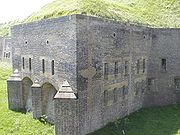
Dover
Dover is a town and major ferry port in the home county of Kent, in South East England. It faces France across the narrowest part of the English Channel, and lies south-east of Canterbury; east of Kent's administrative capital Maidstone; and north-east along the coastline from Dungeness and Hastings...
, with work beginning in 1804. The Western Heights at Dover
Dover Western Heights
The Western Heights of Dover are one of the most impressive fortifications in Britain. They comprise a series of forts, strong points and ditches, designed to protect the country from invasion...
consisted of three parts: the Drop Redoubt, the Citadel and the Grand Shaft. The Drop Redoubt was a detached fort close to the steep cliffs, surrounded by ditches and intended for soldiers to go out and attack French infantry, built between 1804 and 1808. The Citadel was a larger fort surrounded by ditches and was still unfinished when war with France ended in 1815. The Grand Shaft was a barracks containing sixty officers and 1300 NCOs and soldiers, begun in 1806 and completed in 1809.
Telegraphs
In order for the government to better communicate with the coast in case of invasion, a system of telegraphs was constructed. In January 1796, a telegraph line from the Admiralty in London to Deal, KentDeal, Kent
Deal is a town in Kent England. It lies on the English Channel eight miles north-east of Dover and eight miles south of Ramsgate. It is a former fishing, mining and garrison town...
had been built. In December 1796 another telegraph line was constructed between the Admiralty and Portsmouth. In May 1806 a telegraph line from Beacon Hill on the Portsmouth line to Plymouth was built. A subsequent telegraph line was built between the Admiralty and Great Yarmouth, thus telegraphs covered the south-east, south-west and East Anglia. Before, messages between Portsmouth and London had taken several hours (two days for Plymouth) to reach their destination but now communications between London and Portsmouth took only fifteen minutes. Between London and Hythe it was eleven minutes.
Contingency plans
The King made contingency plans in the event of a French landing, with a courtier writing on 13 November 1803: "The King is really prepared to take the field in case of attack, his beds are ready and he can move at half an hour's warning". Another courtier wrote:The king certainly has his camp equipage and accoutrements quite ready for joining the army if the enemy should land, and is quite keen on the subject and angry if any suggests that the attempt may not be made. ... God forbid he should have the fate of HaroldHarold GodwinsonHarold Godwinson was the last Anglo-Saxon King of England.It could be argued that Edgar the Atheling, who was proclaimed as king by the witan but never crowned, was really the last Anglo-Saxon king...
.
The King wrote to his friend Bishop Hurd from Windsor on 30 November 1803:
We are here in daily expectation that Bonaparte will attempt his threatened invasion; the chances against his success seem so many that it is wonderful he persists in it. I own I place that thorough dependence on Divine Providence that I cannot help thinking the usurper is encouraged to make the trial that the ill-success may put an end to his wicked purposes. Should his troops effect a landing, I shall certainly put myself at the head of my troops and my other armed subjects to repel them. But as it is impossible to foresee the events of such a conflict, should the enemy approach too near to Windsor, I shall think it right the Queen and my daughters should cross the Severn, and send them to your Episcopal Palace at Worcester; by this hint I do not the least mean they shall be any inconvenience to you, and shall send a proper servant and furniture for their accommodation. Should this event arise, I certainly would rather have what I value most in life remain, during the conflict, in your diocese and under your roof than in any other place in the island.
The government's contingency plans laid down that the King would go to Chelmsford
Chelmsford
Chelmsford is the county town of Essex, England and the principal settlement of the borough of Chelmsford. It is located in the London commuter belt, approximately northeast of Charing Cross, London, and approximately the same distance from the once provincial Roman capital at Colchester...
if the French landed in Essex
Essex
Essex is a ceremonial and non-metropolitan county in the East region of England, and one of the home counties. It is located to the northeast of Greater London. It borders with Cambridgeshire and Suffolk to the north, Hertfordshire to the west, Kent to the South and London to the south west...
, or to Dartford
Dartford
Dartford is the principal town in the borough of Dartford. It is situated in the northwest corner of Kent, England, east south-east of central London....
if they landed in Kent
Kent
Kent is a county in southeast England, and is one of the home counties. It borders East Sussex, Surrey and Greater London and has a defined boundary with Essex in the middle of the Thames Estuary. The ceremonial county boundaries of Kent include the shire county of Kent and the unitary borough of...
, along with the Prime Minister and the Home Secretary. Lord Cornwallis
Charles Cornwallis, 1st Marquess Cornwallis
Charles Cornwallis, 1st Marquess Cornwallis KG , styled Viscount Brome between 1753 and 1762 and known as The Earl Cornwallis between 1762 and 1792, was a British Army officer and colonial administrator...
would be in command of the reserve army. The Royal Arsenal
Royal Arsenal
The Royal Arsenal, Woolwich, originally known as the Woolwich Warren, carried out armaments manufacture, ammunition proofing and explosives research for the British armed forces. It was sited on the south bank of the River Thames in Woolwich in south-east London, England.-Early history:The Warren...
artillery and stores and the Ordnance Board's powder magazines in Purfleet
Purfleet
Purfleet is a place in the Thurrock unitary authority in Essex, England. It is situated south of the A13 road on the River Thames and within the easterly bounds of the M25 motorway but just outside the Greater London boundary. It was within the traditional Church of England parish of West Thurrock...
, would be put on the Grand Junction
Grand Junction
Grand Junction is the name of several places:United States*Grand Junction, Colorado*Grand Junction, Iowa*Grand Junction, Michigan*Grand Junction, Tennessee*The Grand Junction Railroad in the Boston, Massachusetts areaUnited Kingdom...
canal to the new ordnance depot at Weedon, Northamptonshire
Northamptonshire
Northamptonshire is a landlocked county in the English East Midlands, with a population of 629,676 as at the 2001 census. It has boundaries with the ceremonial counties of Warwickshire to the west, Leicestershire and Rutland to the north, Cambridgeshire to the east, Bedfordshire to the south-east,...
. Soldiers would be paid in gold instead of paper money. The Bank of England
Bank of England
The Bank of England is the central bank of the United Kingdom and the model on which most modern central banks have been based. Established in 1694, it is the second oldest central bank in the world...
books would be sent to the Tower of London and its treasure would be entrusted to Sir Brook Watson
Brook Watson
Sir Brook Watson, 1st Baronet was a British merchant, soldier, and later Lord Mayor of London, perhaps most famous as the subject of Watson and the Shark , a painting by John Singleton Copley which depicted a shark attack on Watson as a boy, as a result of which he lost his right leg below the...
, the Commissary General
Commissariat
A commissariat is the department of an army charged with the provision of supplies, both food and forage, for the troops. The supply of military stores such as ammunition is not included in the duties of a commissariat. In almost every army the duties of transport and supply are performed by the...
, who would transport it in thirty wagons (guarded by a relay of twelve Volunteer escorts) across the Midlands to join the King at Worcester Cathedral
Worcester Cathedral
Worcester Cathedral is an Anglican cathedral in Worcester, England; situated on a bank overlooking the River Severn. It is the seat of the Anglican Bishop of Worcester. Its official name is The Cathedral Church of Christ and the Blessed Mary the Virgin of Worcester...
. The Stock Exchange would close and the Privy Council would take charge in London. The press would be forbidden from printing troop movements and official government communiqués would be distributed. If London fell to the French, the King and his ministers would retreat to the Midlands and "use the final mainstays of sovereignty – treasure and arms – to keep up the final struggle".
Legacy
By the 1 September 1805 Napoleon's invasion camps were empty due to the Grande Armée marching against the AustriansUlm Campaign
The Ulm Campaign consisted of a series of French and Bavarian military maneuvers and battles to outflank and capture an Austrian army in 1805 during the War of the Third Coalition. It took place in the vicinity of and inside the Swabian city of Ulm...
. The Battle of Trafalgar
Battle of Trafalgar
The Battle of Trafalgar was a sea battle fought between the British Royal Navy and the combined fleets of the French Navy and Spanish Navy, during the War of the Third Coalition of the Napoleonic Wars ....
on 21 October relieved British fears of invasion as Admiral Nelson
Horatio Nelson, 1st Viscount Nelson
Horatio Nelson, 1st Viscount Nelson, 1st Duke of Bronté, KB was a flag officer famous for his service in the Royal Navy, particularly during the Napoleonic Wars. He was noted for his inspirational leadership and superb grasp of strategy and unconventional tactics, which resulted in a number of...
destroyed the combined French-Spanish fleet. However the threat of invasion remained so long as Britain was at war with France. At Tilsit in July 1807 Napoleon and the Russian Tsar Alexander I
Alexander I of Russia
Alexander I of Russia , served as Emperor of Russia from 23 March 1801 to 1 December 1825 and the first Russian King of Poland from 1815 to 1825. He was also the first Russian Grand Duke of Finland and Lithuania....
agreed to combine the navies of Europe against Britain. The British responded with a pre-emptive attack on the Danish fleet at Battle of Copenhagen
Battle of Copenhagen (1807)
The Second Battle of Copenhagen was a British preemptive attack on Copenhagen, targeting the civilian population in order to seize the Dano-Norwegian fleet and in turn originate the term to Copenhagenize.-Background:Despite the defeat and loss of many ships in the first Battle of Copenhagen in...
and they also made sure the French never secured the Portuguese fleet. Captain Edward Pelham Brenton
Edward Pelham Brenton
Captain Edward Pelham Brenton was an officer of the British Royal Navy during the French Revolutionary and Napoleonic Wars who military career was relatively quiet, apart from involvement in the capture of Martinique in 1809...
in his Naval History of Great Britain noted that after Trafalgar "another French navy, as if by magic sprang forth from the forests to the seashore, manned by a maritime conscription exactly similar in principle to that edict by which the trees were appropriated to the building of ships". The First Lord of the Admiralty, Lord Melville
Robert Dundas, 2nd Viscount Melville
Robert Dundas, 2nd Viscount Melville KT, PC, FRS was a British statesman, the son of Henry Dundas, the 1st Viscount. Dundas was the Member of Parliament for Hastings in 1794, Rye in 1796 and Midlothian in 1801. He was also Keeper of the Signet for Scotland from 1800...
, noted after the war that given time Napoleon would "have sent forth such powerful fleets that our navy must eventually have been destroyed, since we could never have kept pace with him in building ships nor equipped numbers sufficient to cope with the tremendous power he could have brought against us".

